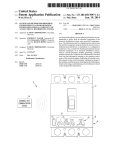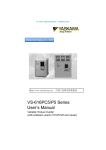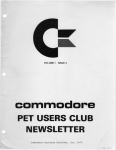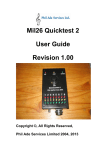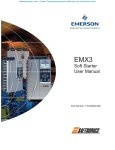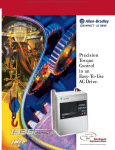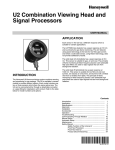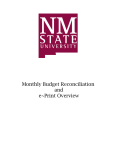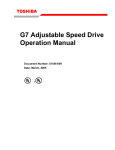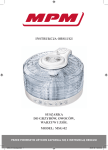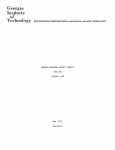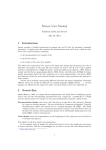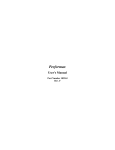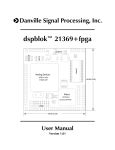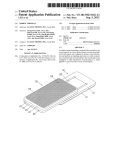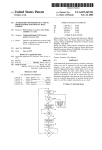Download toshiba s5 inverter user manual
Transcript
efesotomasyon.com -Toshiba inverter,drive,servo,plc toshiba s5 inverter user manual 575 Volt Rating S5 July, 1999 Part #49916-001 efesotomasyon.com -Toshiba inverter,drive,servo,plc TOSHIBA IMPORTANT NOTICE The instructions contained in this manual are not intended to cover all of the details or variations in equipment, nor to provide for all possible issues concerning the installation, operation, or maintenance of this equipment. Should additional information be desired or should particular problems arise which are not covered sufficiently for the purchaser's purposes, the matter should be referred to the local Toshiba sales office. The contents of this instruction manual shall not become a part of or modify any prior or existing agreement, commitment, or relationship. The sales contract contains the entire obligation of Toshiba International Corporation's Adjustable Speed Drive Division. The warranty contained in the contract between the parties is the sole warranty of Toshiba International Corporation's Adjustable Speed Drive Division and any statements contained herein do not create new warranties or modify the existing warranty. Toshiba International Corporation reserves the right, without prior notice, to update information, make product changes, or to discontinue any product and/or service identified in this publication. Any electrical or mechanical modifications to this equipment, without prior written consent of Toshiba International Corporation, will void all warranties and may void UL/CUL listing. Unauthorized modifications also can result in personal injury, death, or destruction of the equipment. AC ADJUSTABLE SPEED DRIVE Please complete the Extended Warranty Card supplied with this drive and return it by prepaid mail to Toshiba. This activates the extended warranty. If additional information or technical assistance is required please contact your local distributor or call Toshiba's ASD marketing department toll free at (800) 231-1412 or write to: Toshiba International Corporation, 13131 W. Little York Road, Houston, TX 77041-9990. Please complete the following information for your records and to remain within this equipment manual: Drive Model Number: Drive Serial Number: Date of Installation: Inspected By: Name of Application: 3 efesotomasyon.com -Toshiba inverter,drive,servo,plc TOSHIBA INTRODUCTION Thank you for purchasing the 575 Volt VFS5 series adjustable speed drive. This adjustable frequency solid-state digital AC drive features vector operation control mode, energy saving mode, built-in speed control potentiometer and a four character 7-segment type LED display with five other discrete LED indicators. This drive is designed for an external braking resistor and DC link reactor. These features, combined with RS232 communication link, make it suitable for a wide variety of applications that require unparalleled motor control and reliability. It is the intent of this operation manual to provide a guide for safely installing, operating, and maintaining the drive. This operation manual contains a section of general safety instructions and is marked throughout with warning symbols. Read this operation manual thoroughly before installing and operating this electrical equipment. All safety warnings must be followed to ensure personal safety. Follow all precautions to attain proper equipment performance and longevity. We hope that you find this operation manual informative and easy to use. For assistance with your drive, information on our free drive application school, or information on Toshiba's complete line of motors, adjustable speed drives, switchgear, instrumentation, uninterruptible power supplies, PLCs, and motor control products, please call toll free (800) 231-1412 or write to our plant at: Toshiba International Corporation, 13131 W. Little York Road, Houston, TX 77041-9990. Again, thank you for your purchase of this product. COPYRIGHT © [JULY, 1999] TOSHIBA INTERNATIONAL CORPORATION 4 efesotomasyon.com -Toshiba inverter,drive,servo,plc TOSHIBA GENERAL SAFETY INSTRUCTIONS Warnings in this manual appear in either of two ways: 1) Danger warnings - The danger warning symbol is an exclamation mark enclosed in a triangle which precedes the 3/16" high letters spelling the word "DANGER". The Danger warning symbol is used to indicate situations, locations, and conditions that can cause serious injury or death: DANGER 2) Caution warnings - The caution warning symbol is an exclamation mark enclosed in a triangle which precedes the 3/16" high letters spelling the word "CAUTION". The Caution warning symbol is used to indicate situations and conditions that can cause operator injury and/or equipment damage: CAUTION Other warning symbols may appear along with the Danger and Caution symbol and are used to specify special hazards. These warnings describe particular areas where special care and/or procedures are required in order to prevent serious injury and possible death: 1) Electrical warnings - The electrical warning symbol is a lighting bolt mark enclosed in a triangle. The Electrical warning symbol is used to indicate high voltage locations and conditions that may cause serious injury or death if the proper precautions are not observed: 2) Explosion warnings - The explosion warning symbol is an explosion mark enclosed in a triangle. The Explosion warning symbol is used to indicate locations and conditions where molten, exploding parts may cause serious injury or death if the proper precautions are not observed: For the purpose of this manual and product labels, a Qualified Person is one who is familiar with the installation, construction, operation and maintenance of the equipment and the hazards involved (see 1996 NEC (National Electric Code) Article 100 - Definitions). This person must: 1) Carefully read the entire operation manual (see 1996 NEC Article 110-3 "Installation and Use"). 2) Be trained and authorized to safely energize, de-energize, clear faults, ground, lockout and tag circuits and equipment in accordance with established safety practices. 3) Be trained in the proper care and use of protective equipment such as safety shoes, rubber gloves, hard hats, safety glasses, face shields, flash clothing, etc. in accordance with established safety practices. 4) Be trained in rendering first aid. 5 efesotomasyon.com -Toshiba inverter,drive,servo,plc TOSHIBA CONTENTS PAGE Disclaimer ........................................................................................................... 3 Introduction ........................................................................................................ 4 General Safety Instructions ........................................................................... 5 Contents .............................................................................................................. 6 - 7 Inspection/Storage/Disposal Inspection of the New Drive .............................................................................. 8 Storage ................................................................................................................. 8 Disposal ................................................................................................................ 8 Inspection and Precautions Installation Safety Precautions ......................................................................... Operating Safety Precautions ........................................................................... Confirmation of Wiring ....................................................................................... Start-up and Test ................................................................................................ Maintenance ........................................................................................................ 9 11 12 12 12 Operating Specifications 575 Volt NEMA Type 1 Chassis Ratings ........................................................ 13 Standard Specifications ..................................................................................... 14 Equipment Wiring Selection of Main Circuit Wiring Equipment and Standard Cable Sizes ........................................................................................ Grounding ............................................................................................................ Motor Selection ................................................................................................... Standard Power Connection Diagrams ........................................................... Standard Power Terminal Functions ............................................................... Typical Control Wiring Connection Diagrams ................................................ Standard Control Terminal Connections and Functions .............................. 16 17 17 18 19 20 22 Operating Panel Operating Panel Layout ..................................................................................... Operating Panel Modes ..................................................................................... Operating Panel Usage ...................................................................................... 7-Segment Alphanumerics ................................................................................ Parameter Setting ............................................................................................... Key Operations .................................................................................................... 24 25 25 26 27 28 6 efesotomasyon.com -Toshiba inverter,drive,servo,plc TOSHIBA CONTENTS (cont'd) PAGE Settings Setting The Acceleration and Deceleration Time .......................................... Increasing Torque ............................................................................................... Setting The Environmental Functions ............................................................. Setting The Starting and Stopping Methods .................................................. Setting The Frequency Command Method .................................................... Connecting and Calibrating Meters .................................................................. Resetting to Default Values ............................................................................... Setting the Motor Protection Characteristics .................................................. Setting The Extended Parameters ................................................................... Searching For Parameters Different From Default Values .......................... 29 29 30 32 32 33 34 34 35 35 Parameter List (Basic and Extended) Basic Parameters (Group No. 00) .................................................................... Extended I/O Parameter (Group No. 01) ........................................................ Extended Frequency Parameter (Group No. 02) ........................................... Extended Operating Mode Parameter (Group No. 03) ................................. Extended Torque Parameter (Group No. 04) ................................................. Extended Accel & Decel Time Parameter (Group No. 05) .......................... Extended Protection Parameter (Group No. 06) ........................................... Extended Panel Parameter (Group No. 07) ................................................... Extended Communication Parameter (Group No. 08) .................................. 36 37 37 38 38 38 39 39 39 Operations Operation with Built-in Potentiometer and RUN /STOP Keys ..................... Operation with Built-in Potentiometer and External Start Signal ................ Setting Frequency Using External Signal ....................................................... Setting Frequency Using Two External Signals ............................................. Selecting a Preset Speed Frequency and Using External Start Signals ... Monitoring Operating Conditions ...................................................................... 40 41 42 43 44 45 Protective Functions Trips and Countermeasures ............................................................................. 46 Resetting Errors When Trip is Activated ......................................................... 47 Dimensions and Weights Dimensions for VFS5-5020UPH through VFS5-5040UPH .......................... 48 Dimensions for VFS5-5060UPH through VFS5-5120UPH .......................... 49 Dimensions for VFS5-5160UPH through VFS5-5270UPH .......................... 50 Tables Input Terminal Selection Table ......................................................................... 51 Output Terminal Selection Table ...................................................................... 52 Default Value Table ............................................................................................ 52 7 efesotomasyon.com -Toshiba inverter,drive,servo,plc TOSHIBA Inspection of the New Drive Upon receipt, inspect the drive for shipping damage. After uncrating: 1) Check the unit for loose, broken, bent or otherwise damaged parts due to shipping. 2) Check to see that the rated capacity and the model number specified on the nameplate conform to the order specifications. Storage 1) Store in a well ventilated location and preferably in the original carton if the drive will not be used immediately after purchase. 2) Avoid storage in locations with extreme temperatures, high humidity, dust, or metal particles. Disposal Please contact your state environmental agency for details on disposal of electrical components and packaging in your particular area. Never dispose of electrical components by incineration. 8 efesotomasyon.com -Toshiba inverter,drive,servo,plc TOSHIBA Installation Safety Precautions CAUTION 1) Always ground the unit to prevent electrical shock and to help reduce electrical noise. A separate ground cable should be run inside the conduit with the input, output, and control power cables (See Grounding page 17). THE METAL OF CONDUIT IS NOT AN ACCEPTABLE GROUND. 2) Only qualified personnel should install this equipment (see General Safety Instructions on page 5). 3) Installation of drive systems should conform as a minimum, to the 1996 NEC National Electrical Code Article 110 "Requirements For Electrical Installations", to all regulations of the Occupational Safety and Health Administration, and to any other applicable national, regional or industry codes and standards. 4) Install in a secure and upright position in a well ventilated location that is out of direct sunlight. The ambient temperature should be between -10° C and 40° C. 5) Allow a clearance space of 4 inches (20 cm) for the top and bottom and 2 inches (5 cm) on both sides. This space will insure adequate ventilation. Do not obstruct any of the ventilation openings. 6) Avoid installation in areas where vibration, heat, humidity, dust, fibers, steel particles, explosive mists, gasses or sources of electrical noise are present. 7) Adequate working space and illumination must be provided for adjustment, inspection and maintenance of the drive (see 1996 NEC Article 110-16). 8) A noncombustible insulating floor or mat should be provided in the area immediately surrounding the electrical system where maintenance is required. 9) Use lockout/tagout procedures on branch circuit disconnect before drive installation. 10) Connect three phase power of the correct voltage to input terminals L1, L2, L3 (R, S, T) and connect 3- phase power from output terminals T1, T2, T3 (U, V, W) to a motor of the correct voltage and type for the application. Size the branch circuit conductors in accordance with Selection of Main Circuit Wiring Equipment and Standard Cable Sizes Page 16. 11) If conductors of a smaller than recommended size are used in parallel to share current then the conductors should be kept together in sets i.e. U1, V1, W1 in one conduit and U2, V2, W2 in another (see 1996 NEC Article 300-20 and Article 310-4). National and local electrical codes should be checked for possible cable derating factors if more than three power conductors are run in the same conduit (see 1996 NEC Article 310 adjustment factors on page 70-196). 12) Install a molded case circuit breaker (MCCB) between the power source and the drive. Size the MCCB to clear the available fault current of the power source (see 1996 NEC Article 430 Article 102 through Article 111). 9 efesotomasyon.com -Toshiba inverter,drive,servo,plc TOSHIBA Installation Safety Precautions (cont'd) CAUTION 13) Use separate metal conduits for routing the input power, output power, and control circuits. 14) If the factory provided door or NEMA 1 enclosure is removed from the drive, then, before operating, it must be provided with an alternate enclosure of NEMA 1 minimum rating. 15) Do not connect control circuit terminal block return connections marked CC to inverter earth ground terminals marked GND(E). See Standard Power Connection Diagrams on page 18 and Typical Control Wire Connection Diagrams on page 20 for locations. 16) If a secondary Magnetic Contactor (MC) is used between the inverter output and the load, it should be interlocked so the ST-CC terminals are disconnected before the output contactor is opened. If the output contactor is used for bypass operation, it must also be interlocked so that commercial power is never applied to the inverter output terminals (U,V,W). 17) Power factor improvement capacitors or surge absorbers must not be installed on the drive's output. 18) For those applications requiring extended ASD to motor cable lengths exceeding the chart recommendation shown on page 17, a output voltage filter should be added. 10 efesotomasyon.com -Toshiba inverter,drive,servo,plc TOSHIBA Operating Safety Precautions CAUTION 1) 2) Do not touch any internal part with power applied to the drive; first remove the power supply from the drive and wait until charge LED (see page 24 for location) is no longer illuminated. Charged capacitors can present a hazard even if source power is removed from the drive. DANGER DO NOT OPERATE THIS UNIT WITH ITS CABINET DOOR OPEN. 3) Do not touch the heatsink while unit is in operation. Serious burns could result. 4) Only properly trained and qualified personnel should be allowed to service or have access to the adjustments and operation of this equipment. They should be familiar with operating motor drives and with the driven machinery. See page 5. 5) Follow all warnings and precautions and use care not to exceed equipment ratings. 6) Do not power up the drive before completely reviewing this manual. 7) The input voltage must be within +/-10% of the specified input voltage. Voltages outside of this permissible tolerance range may cause internal protection devices to turn on or can cause damage to the drive. Also, the input frequency should be within +/-2 Hz of the specified input frequency. 8) Do not use this drive with a motor whose rated input is greater than the rated drive output. 9) Do not apply commercial power to the drive output terminals T1 (U), T2 (V), or T3 (W) even if the source power is off. Disconnect the drive from the motor before applying bypass voltage to the motor. 10) Interface problems can occur when this drive is used in conjunction with some types of process controllers. Signal isolation may be required to prevent controller and/or drive malfunction (contact Toshiba or the process controller manufacturer for additional information about compatibility and signal isolation). 11) Do not open and then re-close a secondary magnetic contactor (MC) between the drive and the load unless the drive is OFF (output frequency has dropped to zero) and the motor is not rotating. Abrupt re-application of the load while drive is on or while motor is rotating can cause drive damage. 12) Use caution when setting output frequency. Overspeeding a motor can decrease its torquedeveloping ability and can result in damage to the motor and/or driven equipment and can result in serious personal injury. 13) Use caution when setting the acceleration and deceleration time. Unnecessarily short times can cause tripping of the drive and mechanical stress to loads. 14) If the drive produces smoke, odor or abnormal noises, turn off input power immediately and request service. 15) If the drive will be inactive for a long period of time, turn off the input power. 11 efesotomasyon.com -Toshiba inverter,drive,servo,plc TOSHIBA Confirmation of Wiring CAUTION Make the following final checks before applying power to the unit: 1) Confirm that source power is connected to terminals L1, L2, L3 (R, S, T). Connection of incoming source power to any other terminals will damage the drive. 2) The 3-phase source power should be within the correct voltage and frequency tolerances. 3) The motor leads must be connected to terminals T1, T2, T3 (U, V, W). 4) Make sure there are no short circuits or inadvertent grounds and tighten any loose connector terminal screws. Start-Up and Test CAUTION Prior to releasing an electrical drive system for regular operation after installation, the system should be given a start-up test by qualified personnel. This assures correct operation of the equipment for reasons of reliable and safe performance. It is important to make arrangements for such a check and that time is allowed for it. When power is applied for the first time, the drive automatically starts up in the frequency monitor function of standard monitor mode with the 'default' parameters set as shown in the "FACTORY SETTING" column of the parameter tables starting on page 36. If these settings are not optimal for the application, program the desired settings before initiating a run. The drive can be operated with no motor connected. Operation with no motor connected or use with a small trial motor is recommended for initial adjustment or for learning to adjust and operate the drive. Maintenance CAUTION 1) Use power lockout/tagout procedures on the disconnecting means in accordance with applicable electrical codes (see 1996 NEC Article 430-101) before performing any drive maintenance. 2) Periodically check the operating drive for cleanliness. 3) Do not use liquid cleaning agents. 4) Keep the heatsink free of dust and debris. 5) Periodically check electrical connections for tightness (with power off, locked out, and with charge LED extinguished (see page 24 for location)). 12 efesotomasyon.com -Toshiba inverter,drive,servo,plc TOSHIBA 575 Volt NEMA Type 1 Chassis Standard Ratings VFS5 NOTES 5020 5030 5040 5060 5120 5160 5220 5270 (1) (1) (1) (1) (1) (1) (1) (1) (see below) MODEL STANDARD RATINGS RATED MOTOR OUTPUT OUTPUT KVA HP(KW) CURRENT VOLTAGE (AMPS) 1 1/.75 2.1 575V 2 2/1.5 3 3-PHASE 3 3/2.2 4 MAX VOLTAGE 6 5/3.8 6.1 12 10/7.5 12 16 15/11 17 22 20/15 22 27 25/18.5 27 NOTES: 1) NEMA Type1 UL/CUL listing 13 OVERLOAD CURRENT MAIN CIRCUIT INPUT POWER 3-PHASE INPUT CONTROL POWER 150% FOR 60 SEC. 100% CONTINUOUS 575V NO EXTERNAL 50/60Hz CONTROL VOLTAGE +/- 10% POWER SOURCE FREQ. +/- 2Hz REQUIRED efesotomasyon.com -Toshiba inverter,drive,servo,plc TOSHIBA Standard Specifications Major Control Specifications Operation functions Control System Sinusoidal PWM control Output voltage regulation Same as power line. Output frequency range 0.5 to 320 Hz (0.5 to 80Hz default setting)*. Maximum frequency is adjustable between 30 and 320 Hz. Frequency setting 0.1Hz input from the operating panel, 0.2 Hz analog resolution input (@ maximum frequency of 100 Hz). Frequency accuracy Analog setting: ±0.5% of the maximum output frequency or less @ 25°C±10°C, Digital setting: ±0.01% of the maximum output frequency or less @ -10°C to +50°C Voltage/frequency Constant V/f, variable torque mode, sensorless vector control characteristics mode, automatic torque boost mode, base frequency adjustment (25 to 320Hz), and torque boost adjustment (0 to 30%). Overload current rating 150%, 60 seconds Frequency setting signal Built-in potentiometer on the front panel, external potentiometer (1k ohm to 10k ohm variable resistor connectable), 0 to 10Vdc (input impedance: VIA = 30.55k ohm, VIB=30k ohm), 4 to 20mAdc (input impedance = 400 ohm), and optional characteristics (gain,bias) can be preset by 2-point setting PI control Proportional gain, integral gain adjustments. Start frequency Adjustable between 0 and 10Hz Frequency jump Three points (by setting jump frequencies and band widths) PWM carrier frequency Adjustable between 2.2 and 12kHz (default = 12kHz) Accel/decel time 0.1 to 3600 secs, accel/decel time 1 or 2 selectable, S1 and S2 accel/decel pattern selectable Jogging run Jog run from panel with JOG mode selection. Terminal block operation possible with parameter settings (see page 37). Preset speed operation Set frequency +15 preset speeds possible with open/closed combinations of SS1, SS2, SS3, SS4 and CC Retry operation A maximum of ten automatic retries are selectable (see page 38) Retry will occur immediately after a self evaluation of the main circuit is completed. Braking Externally connected braking resistor (optional) DC braking Braking start frequency (0 to max frequency), braking level (0 to 100%), braking time (0 to 20 seconds). Output voltage regulation Drive can be programmed to set the maximum output voltage, float with the input voltage, or set the maximum output voltage to the voltage sensed at power-up. Input terminal functions Forward and reverse input signals, preset speed select input signals, reset input signals, and etc (see page 37). Output terminal functions Low-speed detection output signals, speed reached output signals, and etc. Fault signal 1c contact output (250 Vac, 30 Vdc - 2A resistive load, 250 Vac, 30 Vdc - 1.5A inductive load, cosØ =0.4 Output for frequency Analog output (1 mA dc full scale ammeter or 7.5 Vdc, 1mA counter or ammeter full scale DC ammeter or rectifying AC voltmeter, 225% current max., 1mA DC, 7.5 Vdc full scale)(see page 33) 14 efesotomasyon.com -Toshiba inverter,drive,servo,plc TOSHIBA Standard Specifications (cont'd) Display Inverter/Motor Enclosure Keypad Interface Protective functions Protection from instantaneous power failure Electronic thermal characteristics Type Cooling method Service environment Ambient temperature Relative humidity Vibration Climatic class Polution degree IP rating 4-digit, 7-segment LEDs w/8 discrete indicator lamps. Stall prevention, current limit, overcurrent, overvoltage, output short-circuit , overvoltage limit, undervoltage, electronic thermal overload protection, armature overcurrent during starting, overcurrent on load-side when starting-up, and emergency stop (selection) Auto-restart and regeneration power ride-through control Standard motor and constant torque VF motor selectable; overload trip and overload stall selectable NEMA Type 1 Forced air cooling Indoor. Altitude of < 1000m Must not be exposed to direct sunlight, corrosive and/or explosive gases or mists, fibers and dusts. From -10°C to 40°C (14°F to 104°F). 93% maximum (non-condensating) 5.9 m/s (0.6G) maximum (10 to 55Hz) 3K3 2 2X 15 efesotomasyon.com -Toshiba inverter,drive,servo,plc TOSHIBA Selection of Main Circuit Wiring Equipment and Standard Cable Sizes * Molded case Ampacity circuit breaker (FLA x 1.25) (MCCB) Drive ** Typical cable size (AWG) Model Number Amp rating (A) (A) Main power and motor load S5-5020 15 3 #14 S5-5030 15 4 #14 S5-5040 15 5 #14 S5-5060 15 8 #14 S5-5120 30 15 #14 S5-5160 35 22 #12 S5-5220 50 28 #10 S5-5270 60 34 #10 Frequency command input, frequency meter, ammeter Other signal circuits 3-core shield cable (speed reference) 2-core shield cable #20 #18 * A customer supplied disconnect means must be provided in the motor branch circuit which supplies power to the drive. It can be separate for use with customer supplied fuses or it can be an integral part of a customer supplied 3-pole circuit breaker (see 1996 NEC Article 430-103 through 430-113). All drives in this series are rated for output short circuit fault currents of 200,000A. The selection of MCCB (molded case circuit breaker) for this table is in accordance with 1996 NEC Article 430-51, 430-52, 430-152, and 240-6. ** Wire sizing is based upon NEC table 310-16 or CEC Table 2 using 75 deg C cable, an ambient of 30 deg C, cable runs for less than 300 FT., and copper wiring for not more than three conductors in raceway or cable or earth (directly buried). The customer should consult the NEC or CEC wire Tables for his own particular application and wire sizing. *** Use two parallel conductors instead of a single conductor (this will allow for the proper wire bending radius within the cabinet). Use separate conduits for routing parallel conductors. This prevents the need for conductor derating (see note 3 page 17). CAUTION Turn off power to the drive before making any wiring changes to the analog output circuits. CAUTION Use separate conduits for routing incoming power, power to motor, and control conductors. Use no more than three power conductors and a ground conductor per conduit. See next page for notes. 16 efesotomasyon.com -Toshiba inverter,drive,servo,plc TOSHIBA Selection of Main Circuit Wiring Equipment and Standard Cable Sizes (cont'd) Notes: 1.) Contacts used to connect drive terminals should be capable of switching low current signals (i.e. 5 mA). 2.) The drive has internal motor overload protection which has been functionally certified by Underwriters Laboratories Inc. and no additional external motor overload protection is required when used to drive a single motor load (see 1996 NEC Article 430-32 and 430-39). 3.) When wiring with parallel conductors, the conductors should be kept together in phase sets to avoid heating the surrounding metal by induction. Install U1, V1, W1 conductors in one conduit and parallel conductors U2, V2, W2 in another conduit. The ground conductor must be run in the same conduit. See 1996 NEC Article 300-20(a), 310-4, 310-5. Size the grounding conductor in accordance with 1996 NEC Table 250-95. 4) Twisted pair wires should be used for external meters connected to AM and FM terminals. 5) For multiple motor applications, a thermal-magnetic circuit breaker must be installed between the drive and each motor (even though the drive has has built-in overload protection). The thermal circuit is for overload sensing and the magnetic coil is for abnormal conditions such as short circuits. Select the MCCB (molded case circuit breaker) in accordance with 1996 NEC Article 430-51 through 430-53, 430-152, and 240-6. Grounding The drive must be grounded in accordance with Article 250 of the National Electrical Code or Section 10 of the Canadian Electrical Code, Part I and the grounding conductor should be sized in accordance with 1996 NEC Table 250-95 or CEC, Part I Table 16. See Installation Safety Precautions notes 7 and 14. CAUTION Conduit is not a suitable ground for the inverter. Motor Selection 1) Exceeding the peak voltage rating or the rise time allowable of the motor insulation system will reduce the life expectancy. To insure good motor insulation life, consult with the motor supplier to determine motor insulation ratings and allowable maximum output lead distance. Long lead lengths between the motor and the drive may require filters to be added to the drive output. 1 Suggested Maximum Output Lead Distance AC Motor Voltage 575 V 1 2 PWM Carrier Frequency NEMA MG-1-1998 Section IV Part 31 Compliant Motors 2 < = 5 kHz 200 ft. > 5 kHz 100 ft. For lead lengths that exceed suggested maximum contact your local distributor or Toshiba for additional application assistance. Toshiba EQP III, III-XS & EQP III-841 motors incorporate an insulation system that is in compliance with NEMA MG-1-1998 Section IV Part 31. 2) Bearing Considerations: Motors operating from adjustable speed drive power sources tend to operate at higher temperatures which may increase the need for more frequent lubrication cycles. 17 efesotomasyon.com -Toshiba inverter,drive,servo,plc TOSHIBA Standard Power Connection Diagrams VFS5-5020UPH through VFS5-5040UPH Braking resistor (Optional) DC link reactor (Optional) L1 L2 L3 G/E PO PB PA U/T1 V/T2 W/T3 G/E MCCB Commercial power supply Shorting bar Motor VFS5-5060UPH through VFS5-5120UPH Braking resistor (Optional) DC link reactor (Optional) R/L1 S/L2 T/L3 G/E PO PA PB U/T1 V/T2 W/T3 MCCB Commercial power supply Shorting bar 18 Motor G/E efesotomasyon.com -Toshiba inverter,drive,servo,plc TOSHIBA Standard Power Connection Diagrams (cont'd) VFS5-5160UPH through VFS5-5270UPH Braking resistor (Optional) PA PB PC PO R/L1 S/L2 DC link reactor (Optional) Shorting bar T/L3 G/E U/T1 V/T2 W/T3 G/E MCCB Motor Commercial power supply Standard Power Terminal Functions Terminal name Terminal functions L1, L2, L3 (R, S, T) Line input supply terminals for models S5-5020 to S5-5270: Connect to 3ø, 50 or 60Hz, 200 to 545 to 605VAC. Drives can be operated on single phase power when appropriately derated; contact Toshiba distributor for information. T1, T2, T3 (U, V, W) Motor output terminals. Connect these terminals to a 3-phase induction motor of the proper voltage, current, and horsepower. PA, PB Braking resistor output terminals. Connect to an external dynamic braking resistor (DBR). PA, PO DC link reactor output terminals. Connect to an external inductor. G/E (2-terminals) This is the earth ground terminal (ground incoming power and outgoing motor load). 19 Terminal location Terminal block or bus bar efesotomasyon.com -Toshiba inverter,drive,servo,plc TOSHIBA Typical Control Wiring Connection Diagrams Frequency setting: Built-in potentiometer Start and stop: External signals Frequency setting: External signal (0 to 10V voltage signal) Start and stop: External signals Remote/local operation selection Frequency setting: External signal (0 to 10V voltage signal or 4 to 20 mA current signal) Start and stop: External signals 20 efesotomasyon.com -Toshiba inverter,drive,servo,plc TOSHIBA Typical Control Wiring Connection Diagrams (cont'd) Frequency setting: External potentiometer Start and stop: External signals Frequency setting: External signal (4 to 20mA current signal) Start and stop: External signals Frequency setting: Three preset speed selection Start and stop: External signals Preset speed selection chart S1 S1 S1 S1 21 OFF ON OFF ON S2 S2 S2 S2 OFF OFF ON ON Speed 1 Speed 2 Speed 3 efesotomasyon.com -Toshiba inverter,drive,servo,plc TOSHIBA Standard Control Terminal Connections and Functions Terminal block name I/O F I Function Electric rating Motor rotates clockwise when the F terminal is connected to the CC terminal. Motor rotates counterclockwise when the R terminal is connected to the CC terminal. Motor rotates counterclockwise when F and R terminals are connected simultaneously with the CC terminal. 24 Vdc, 10 mA dry contact input R I S1 I Control input signal. Factory set, select preset speed operation when the S1 terminal is connected with the CC terminal. 24 Vdc, 10 mA dry contact input S2 I Control input signal. Factory set, select preset speed operation when the S2 terminal is connected with the CC terminal. 24 Vdc, 10 mA non-voltage contact input RST I Error output signal is reset when the RST terminal is connected with the CC terminal. CC FM OUT1 OUT2 24 Vdc, 10 mA dry contact input Common Control common signal (not connected to the fault output). Both CC terminals are internally connected. O O O Analog meter output frequency or output current can be measured. Output frequency is factory set. 1 mA full scale DC ammeter or 7.5 Vdc, 1mA DC voltmeter Control output signal. The low speed signal is selected by default. (Connects to the CC terminal when the operation frequency exceeds the F100 frequency.) 24 Vdc, 50 mA open collector output maximum Control output signal. The speed-reached signal is selected by default. (Connects to the CC terminal when the operation frequency reaches F101 frequency). 22 Inverter internal circuit 24 Vdc, 50 mA open collector output maximum Typical Input Circuit for F, R, S1, S2, RST efesotomasyon.com -Toshiba inverter,drive,servo,plc TOSHIBA Standard Control Terminal Connections and Functions (cont'd) Terminal block name CC I/O Function Electric rating Common Control common signal (not connected to the fault output). Both CC terminals are connected together. II I 4 to 20 mA (Input Frequency reference (4-20mA). Used to set output frequency via impedance: 400 a 4-20mA current signal supplied ohm) from the user’s controller. Cannot be used with the VIA signal. VIA I Frequency reference (0-10V). 0 to 10 V (Input Used to set output frequency via impedance: 35.55 a 0-10V voltage signal supplied kohm) from the user’s controller. Cannot be used with the II signal. VIB I Frequency reference (0-10V). Used to set output frequency via a 0-10V voltage signal supplied from the user’s controller. 0 to 10 V (Input impedance: 30 kohm) PP O Power supply for the external potentiometer 10 Vdc, (Connectable potentiometer: 1k to 10k ohm, 1/4 W). P24 O Power supply for the external relay 24 Vdc, 100 mA FLA O Fault output. Connected with the FLC terminal if a fault occurs (normally open). 250 Vac, 2 A FLB O Fault output. Connected with the FLC terminal in the normal condition (normally closed). 30 Vdc, 2 A resistive load FLC O Fault latch output. A common terminal for FLA and FLB. 30 Vdc, 1.5 A inductive load 23 Inverter internal circuit efesotomasyon.com -Toshiba inverter,drive,servo,plc TOSHIBA Operating Panel Layout RUN lamp: When lit the drive is running. CHARGE lamp: This lamp indicates that the internal circuits of the drive are charged with high voltages. When lit, do not open the terminal block cover. Display unit: The operating freq, parameters, faults, etc. are displayed on the LED display. VEC lamp: When lit the system is running in the vector operation control mode. MON lamp: When lit, the display unit is in monitor mode. ECN lamp: When lit the system is running in the economy ( energy saving ) mode. PRG lamp: When lit, the display unit is in parameter setting mode. Built-in potentiometer lamp: When lit, the operation frequency can be set with the built-in potentiometer RUN key lamp: When lit the RUN key can be used. RUN key: To start operation, press this key while the RUN key lamp is on. Built-in potentiometer: When the potentiometer lamp is lit, the operation frequency can be set with this control. STOP key: Press this key to stop operation. ENT (enter) key UP key DOWN key MON (monitor) key UP and DOWN keys: Press these keys to increase or decrease the frequency during operation. 24 efesotomasyon.com -Toshiba inverter,drive,servo,plc TOSHIBA Operating Panel Modes The following conditions are displayed on the operation panel. 1) Frequency, 2) parameter display or changes, and 3) drive condition during operation or in case of an error. Keys Display Unit : Selects 1), 2) and 3) in this MON key order. Pressing the MON key displays the first item of the following mode. In the parameter display or change mode, “AU1” is displayed. In the drive condition display mode, “Fr-F” or “Fr-r” is displayed. ON/RUN VEC Vector operation ECN mode Energy saving mode : Selects the displayed item or stores it in the drive. ENT key UP key MODE 3 ON when displaying drive condition MODE 1 Running (during drive output) MON aU1 PRG MODE 2 ON when displaying the parameter set value Mode 1): The output frequency is displayed, or fault contents are displayed if the unit is faulted. : Displays the next item or increases a numeric value. Mode 2): A parameter name or parameter set value is displayed. : Displays the previous item or decreases a numeric value. DOWN key Mode 3): The drive condition is displayed. Operating Panel Usage Parameter display/setting Drive condition display When displaying the history log of past errors, the orders and contents are displayed alternately 25 efesotomasyon.com -Toshiba inverter,drive,servo,plc TOSHIBA 7-Segment Alphanumerics The 7 segment LED display has a limited number of output characters, therefore the following figures and letters will be used for the display: Numerics LED display Characters LED display 0 0 A,a A 1 1 B,b b 2 2 C,c C 3 3 D,d d 4 4 E,e E 5 5 F,f F 6 6 G,g G 7 7 H H 8 8 h h 9 9 I,i I - - J,j J L,l L M,m M N,n n O O o o P,p P Q,q b R,r r S,s S T,t t U,u U V,v v Y,y y 26 efesotomasyon.com -Toshiba inverter,drive,servo,plc TOSHIBA Parameter Setting There are three parameter groups as shown below: Basic Parameters User Changed Parameters Parameters which determine the basic drive operations Parameters changed by the user. See "Searching for Parameters different from Default Values" below. aU1 gr.U f--sr1 - Sr7 Extended Parameters Parameters for using the extended function fmOd cmOd aU3 aU2 Notes: F100.F101.---.F999 See "Setting Extended Parameters below. 1) If you become confused during operation, press the MON key several times to return to the frequency display. 2) The VFS5 drive has three convenient automatic operation functions (automatic acceleration and deceleration, automatic torque boost, and automatic environment setting). In the following operation, parameters do not need to be set. (These functions may not work properly for some load conditions.) Acceleration and deceleration time: Automatic Torque boost: Automatic torque boost or vector operation control Quick Setup: Motor base/maximum frequency 50/60 Hz selection 3) There are some parameters that cannot be changed while running. See the parameter list. 27 efesotomasyon.com -Toshiba inverter,drive,servo,plc TOSHIBA Key Operations Example of parameter selection with UP and DOWN keys Checking Parameter Set Values Parameter selection Parameter set value Example of Parameter Selection with UP and DOWN Keys Changing a Parameter Parameter selection CAUTION Parameter set value Parameter settings are accepted and fed back to the motor operation even while the motor is running. When you change the parameter settings during operation, pay attention to how the motor is running. 1) Turn on the power. 2) Press the MON key until AUI is displayed on the display unit. 3) Select the desired parameter name from the parameter list starting on page 36. Press the UP or DOWN key until the parameter name is displayed. 4) When the desired parameter name is displayed, press the ENT key. The parameter set value is displayed. 5) To change the parameter set value, press the UP or DOWN key. (3) (5) 6) To store the displayed parameter set value in the drive, press the ENT key. The parameter name and changed set value are displayed alternately, then the parameter name is displayed. 7) To set another parameter, repeat step (3). 8) To finish parameter setting, press the MON key twice. The current frequency is displayed. 28 (4) (6) (2) (8) efesotomasyon.com -Toshiba inverter,drive,servo,plc TOSHIBA Setting The Acceleration and Deceleration Time Applicable parameters: Automatic acceleration and deceleration AU1, AU1 acceleration time by the drive, and manual setting. There are two methods of setting the acceleration and deceleration time: Automatic setting of the acceleration and deceleration time by the drive, and manual setting. 1) Automatic acceleration and deceleration time setting To select automatic acceleration and deceleration time setting, set the AUI value to 1. Note: When automatic acceleration and deceleration time setting is selected, the acceleration and deceleration time is always varied according to the load conditions. If the machine requires a predetermined acceleration and deceleration time, use the manual acceleration and deceleration time setting function. 2) Manual acceleration and deceleration time setting Set the AUI value to 0. Then, set the ACC and dEC values to the desired acceleration time and deceleration time, respectively. Maximum frequency fH Acceleration time acc Deceleration time dec Increasing Torque Applicable parameters: Automatic torque boost aU2, aU2 and torque boost ub. ub The motor torque can be increased by raising the inverter output voltage. There are two methods of raising the output voltage: 1) automatic voltage raising by the drive and 2) manual voltage raising. Note: If the output voltage is increased too much, the drive may trip overcurrent. This may lead to drive and/or motor damage. 1) Automatic torque boost and improving the speed accuracy: Set the AU2 value to 1. The torque is automatically increased. To increase the speed accuracy, set the AU2 value to 3. If operation is not stable when AU2 is set to 2 or 3, set aU2 to 1, and the operation will become stable. 2) Increasing drive output manually: Set the AU2 value to 0 and increase the ub value. Start with a value of 3 and increment by units pf one. Chect for low current and smooth operation at each setting and select the best value. 29 efesotomasyon.com -Toshiba inverter,drive,servo,plc TOSHIBA Setting the Environmental Functions (Maximum Frequency, Upper and Lower Limits, Base Frequency, Etc. Applicable parameters: Automatic environment setting AU3, AU3 upper limit frequency UL, UL maximum frequency FH, FH lower limit frequency LL, LL and base frequency uL, uL (VIA/II input point 2 frequency F204, F204 auto-restart F30I, F30I regeneration power ride-through control F302, F302 pattern of acceleration and deceleration F502, F502 output voltage adjustment F306, F306 power voltage compensation F307, F307 and VIB point 2 frequency F2I3) F2I3 The drive has various functions for setting the environment to ensure trouble-free operation. These functions can be selected in two ways, automatic selection by the drive, and manual selection. typ1 Output typ2 ub1 0% 0.0Hz 50Hz 60Hz Output frequency * Ul ** 100% % Voltage Output frequency 100% 60 Hz operation Output frequency 50 Hz operation * ll *** 100% % Voltage * Maximum frequency ** Maximum frequency *** Maximum frequency Quick Setup Parameters The set values differ with the source voltage rating of the motor as shown below: 50 Hz motor: Set AU3 to 1. 60 Hz motor: Set AU3 to 2. CAUTION Select a suitable source voltage for the motor. Improper voltage selection could result in rotation failure or, in the worst case, the motor could be damaged. Notes: 1) The 'Quick Setup Function' sets the motor speed lower than the frequency command in case of an instantaneous power failure. If this has an adverse effect on the machine, change it by setting manually. The automatic environment settings are as shown on page 31. 30 efesotomasyon.com -Toshiba inverter,drive,servo,plc TOSHIBA Setting the Environmental Functions (Maximum Frequency, Upper and Lower Limits, Base Frequency, Etc. (cont'd) Quick Setup Parameters (cont'd) Parameter When AU3 is set to 1 Description When AU3 is set to 2 Maximum frequency: FH Maximum output frequency of the drive 50 Hz 60 Hz Upper limit frequency: Ul Upper limit frequency of the drive 50 Hz 60 Hz Base frequency: ul Rated frequency of the motor 50 Hz 60 Hz Frequency at VIA/II input point 2: f204 Output frequency when a 10 V voltage command is input 50 Hz 60 Hz Frequency at VIB input point 2: f213 Output frequency when a 10 V voltage command is input 50 Hz 60 Hz Auto restart: f301 Operation restarts according to the motor speed automatically if F-CC is ON when the power is recovered from instantaneous power failure. 1: Instantaneous power failure restart control is effective Same as left Regeneration power ride through control: f302 In case of an instantaneous power failure, the motor speed is reduced automatically to continue operation. 1: Instantaneous power failure nonstop control is effective. Same as left Source voltage compensation: f307 Control is performed so that the output voltage does not lower when the source voltage drops. 1:Source voltage. compensation is effective. Same as left Pattern of acceleration and deceleration: f502 An S pattern is used to accelerate and decelerate the motor speed. 1:S pattern. Same as left Manual drive environment setting Set AU3 to 0, then set the parameters individually. CAUTION Do not set the maximum frequency above 80 Hz if the motor is a generalpurpose motor not designed for high-speed operation. 31 efesotomasyon.com -Toshiba inverter,drive,servo,plc TOSHIBA Selecting the Starting and Stopping Method Applicable parameters: Command mode selection cmOd There are two starting and stopping methods as shown below. Select either method. Starting and stopping method Set value Description Terminal Block 0 The motor starts when the F (forward) or R (reverse) terminal on the terminal block is connected to CC. Acceleration and deceleration is performed at the programmed rate shown in the Basic Parameters on page 36. RUN / STOP keys 1 When the RUN key on the panel is pressed, the motor is accelerated according to the acceleration pattern. When the STOP key is pressed, the motor is decelerated according to the deceleration pattern. Setting the Frequency Command Method Applicable parameters: Frequency setting mode selection fmOd There are three methods of setting the frequency. Select a suitable method. Frequency setting method Set value Description Terminal block 0-10V, 4-20mA External potentiometer 0 A frequency setting input to VIA, VIB or II on the terminal block is used. UP / DOWN keys 1 The frequency set with the 'up' or 'down' key on the panel is used. The UP/DOWN key lamp is on when this function is enabled. Built-in potentiometer 2 The value set with the built-in potentiometer is used. The built-in potentiometer lamp is on when this function is enabled. Use the parameter F200 to specify the order of priority of two frequency commands to be input to the terminal block. Settings of frequency priority parameter F200 Prior terminals 0 VIA or II If 0 is input to the VIB terminal, a command input to the VIA or II terminal is valid. 1 VIB If 0 is input to the VIA and II terminals, a command input to the VIB terminal is valid. Description 32 efesotomasyon.com -Toshiba inverter,drive,servo,plc TOSHIBA Connecting and Calibrating Meters Applicable parameters: FM terminal function selection fmsl, fmsl meter adjustment FM An analog meter can be connected to the FM terminal to act as a frequency meter or an output current meter. How to connect a meter to measure frequency Set the FMSL value to “0”. It is set to “0” by default. How to connect a meter to measure ouput current Set the FMSL value to “I”. When measuring output current, use a meter whose full scale rating (1mA or 7.5V) is equivalent to 2.25 times the rated inverter current. (6) How to calibrate the frequency meter or ammeter 1) Start the drive. When an ammeter is to be adjusted, connect the motor. (See “OPERATIONS”.) 2) Increase the frequency within the safe range. 3) Press the MON key to display AUI. (5) (8) (3) (9) (4) (7) 4) Press the UP key six times to display Fm. 5) Press the ENT key. 6) The operation frequency or current (%) is displayed on the display. 7) Adjust the reading of the analog meter to the displayed frequency or current with the UP or DOWN key. - 8) After completing the adjustment, press the ENT key. + 1 mA ammeter of 7.5Vdc voltmeter 9) Press the MON key twice. The current frequency is displayed. 10) Stop the drive. 33 efesotomasyon.com -Toshiba inverter,drive,servo,plc TOSHIBA Resetting to Default Values Applicable parameters: Standard setting mode selection tYP All parameters can be reset to the default values when set to “3”. If the 50 Hz or 60 Hz setting is selected, FH, UL, uL, F204, F213 are set for 50 Hz or 60 Hz and other parameters are set to the factory default values. The tYP parameter cannot be changed while running. Settings Set value Not changed 0 Parameter setting for 50 Hz motor 1 Accumulative time is cumulative run time for which the inverter output frequency is more than 0.0Hz and unit is 100 hours. Parameter setting for 60 Hz motor 2 ** tYP 6 is used to clear an EtYP error that Default setting (All parameters) 3 Clears the error log 4 Clears accumulative run time * 5 Initialize drive typeform ** 6 * may occur when the control PCB is installed in a different inverter unit and to reset the typeform to that of the new drive. Notes: 1) When this parameter is selected, the previous set value is displayed at the left end and 0 is always displayed at the right end. The previous set value is 3 by default. 2) Parameters different from the default values can be checked using the user parameter group gr.U. Setting The Motor Protection Characteristics Applicable parameters: Selection of electric thermal protection characteristics OLn The "thermal protection type" can be specified according ot the motor type. Normally select 0 for the motor or 4 for a VF motor for the drive. Notes: 1) The selection of electric thermal protection in the drive eliminates the need to use an external thermal relay for motor protection. 2) If the rated current is different from the rated motor current (continuous), set the ratio using parameter f600. CAUTION If a single drive is used to control several motors, install a seperate thermal relay for each motor. Set the the thermal function F600 to match the rated current of the motor. Failure to correctly set this value could result in motor overheating and a possible fire. 34 efesotomasyon.com -Toshiba inverter,drive,servo,plc TOSHIBA Setting The Extended Parameters Applicable parameters: Extended parameters f--The extended parameters are used to make the drive deliver its full performance. To use the extended parameters, call the parameter f--- and press the ENT key. The extended parameter number is displayed. Once the number is displayed, the extended parameter can be set in the same way as the normal parameters. After setting the extended parameters, press the MON key. Refer to pages 37 to 39 for lists of the extended parameters. For detail of the parameters and how to use them, contact your Toshiba distributor. Searching For Parameters Different from Default Values Applicable parameters: Automatic edit function Gr.U The parameters which are different from the default values can be displayed. Call the parameter Gr.U, Gr.U then press the ENT key. The names of the parameters which are different from the default values are displayed. If several parameters are different from the default values, they can be seen by pressing the UP or DOWN key. These parameters can be changed in the same way as the normal parameters. After completing the operation, press the MON key. 35 efesotomasyon.com -Toshiba inverter,drive,servo,plc TOSHIBA Parameter List Basic Parameters (Group No. 00) Display Function Adjustable range Default value aU1 Automatic acceleration and deceleration 0: No, 1: Yes 0 aU2 Automatic torque boost * 0: No 1: Automatic torque boost 0 * These parameters cannot be changed while running aU3 Automatic environment setting * 2: Sensorless vector control 3: Sensorless vector control with automatic tuning 0: No 0 1: Automatic 50 Hz motor cMOd Command mode selection 2: Automatic 60 Hz motor 0: Terminal block, 1: Panel 1 fMOd Frequency setting mode selection 0: Terminal block, 1: Panel , 2: Built-in potentiometer 2 fMsl fM FM terminal function selection Connected meter adjustment 0: Frequency meter, 1: Output current meter Frequency or current displayed 0 - typ Standard setting mode selection * 0: No action, 3 1: 50 Hz standard 2: 60 Hz standard 3: Default setting 4: Clears error log 5: Clearing accumulated operation time 6: Initialize inverter typeform fr acc Forward/reverse selection (Panel) Acceleration time #1 (s) dec 0: Forward, 1: Reverse 0.1 ~ 3600 0 10.0 Deceleration time #1 (s) 0.1 ~ 3600 10.0 fH UL Max. frequency (Hz) * Upper limit frequency (Hz) 30.0 ~ 320.0 0.5 ~ FH 80.0 80.0 ll Lower limit frequency (Hz) 0.0 ~ UL ul pt Base frequency (Hz) V/f pattern * 0.0 25.0 ~ 320.0 60.0 0 0: Constant V/f 1: Square reduction 2: Automatic torque boost 3: Sensorless vector control 4: Automatic energy saving ub OLM Voltage boost (%) Selection of electronic thermal protection 0.0 ~ 30.0 Refer to Default Value table page 52 Setting Type characteristics 0 1 F--- Extended parameters grU Automatic edit function O X O O X X 3 X O 5 Preset speed 1 to 7. (Hz) Overload stall 2 4 Sr1~ Sr7 Standard motor Overload protection V/F motor O X O O 6 X X 7 X O LL ~ UL --Changed parameters displayed 36 Table 0 0.0 efesotomasyon.com -Toshiba inverter,drive,servo,plc TOSHIBA Parameter List (cont'd) Extended Parameters (I/O Group No. 01) Display Function Adjustable range Default value FI00 Low speed signal output (Hz) 0.0 ~ FH 0.0 FI0I FI02 Speed reach HI frequency (Hz) Acc/Dec complete detection 0.0 ~ FH 0.0 bandwidth (Hz) 0.0 ~ FH 2.5 FI03 FI04 ST signal selection RST signal selection 0: Standard, 1: Normally ON, 2: Linking with F/R 0: Standard, 1: Resetting if no signal is input to terminal 1 0 FII0 Always active function selection 0 ~ 37 Refer to Input Terminal Selection table page 51. 0: No function provided FIII FII2 Input terminal selection #1 Input terminal selection #2 0 ~ 37 Refer to Input Terminal Selection table page 51. 0 ~ 37 Refer to Input Terminal Selection table page 51. 2:F 3:R FII3 Input terminal selection #3 0 ~ 37 Refer to Input Terminal Selection table page 51. 10 : RST FII4 FII5 Input terminal selection #4 Input terminal selection #5 0 ~ 37 Refer to Input Terminal Selection table page 51. 0 ~ 37 Refer to Input Terminal Selection table page 51. 6 : S1 7 S2 FI30 Output terminal selection #1 0 ~ 9 Refer to Output Terminal Selection table page 52. 4 : LOW FI3I Output terminal selection #2 0 ~ 9 Refer to Output Terminal Selection table page 52. 6 : RCH Extended Parameters (Frequency Group No. 02) Display Function Adjustable range Default value F200 Frequency priority selection F20I F202 VIA reference point #1 (%) VIA point #1 frequency (Hz) 0 ~ 100 0.0 ~ 320.0 0 0.0 F203 VIA reference point #2 (%) 0 ~ 100 100 F204 F2I0 VIA point #2 frequency (Hz) VIB reference point #1 (%) 0.0 ~ 320.0 0 ~ 100 80.0 0 F2II VIB point #1 frequency (Hz) 0.0 ~ 320.0 0.0 F2I2 F2I3 VIB referfence point #2 (%) VIB point #2 frequency (Hz) 0 ~ 100 0.0 ~ 320.0 100 80.0 F240 Start-up frequency (Hz) 0.5 ~ 10.0 0.5 F24I F242 Run frequency (Hz) Run frequency hysteresis (Hz) 0.0 ~ FH 0.0 ~ FH 0.0 0.0 F250 DC injection starting frequency (Hz) 0.0 ~ FH 0.0 F25I F252 DC injection current (%) DC injection time (s) 0 ~ 100 0.0 ~ 20.0 30 1.0 F260 Jog run frequency (Hz) 0.0 ~ 20.0 0.0 F26I F270 Jog stop control Jump frequency #1 (Hz) 0: Ramp to stop 1: Coast to stop 2: DC LL ~ UL 0 0.0 F27I Jump frequency band #1 (Hz) 0.0 ~ 30.0 0.0 F272 F273 Jump frequency #2 (Hz) Jump frequency band #2 (Hz) LL ~ UL 0.0. ~ 30.0 0.0 0.0 F274 Jump frequency #3 (Hz) LL ~ UL 0.0 F275 F280 Jump frequency band #3 (Hz) Preset speed 1 to 15 (Hz) 0.0 ~ 30.0 LL ~ UL 0.0 0.0 0 : VIA, II 1 : VIB -F284 37 0 efesotomasyon.com -Toshiba inverter,drive,servo,plc TOSHIBA Parameter List (cont'd) Extended Parameters (Operating Mode Group No. 03) Display Function Adjustable range Default value F300 PWM carrier frequency (kHz) F30I Auto-restart 0: No, 1: Instantaneous power failure, 2: ST, 3: Instantaneous power failure + ST 0 F302 Regeneration power ride-through control 0: No, 1: Yes 0 F303 F304 Retry selection (Number of times) Regenerative braking selection 0 ~ 10 0: No, 1: Yes 0 0 F305 Overvoltage stall protection 0: Enabled, 1: Disabled F306 F307 Output voltage adjustment (%) Line voltage compensation 0 ~120 (cannot be changed while running) 0: No, 1: Yes 0 F308 Braking resistor overload detection time constant 1 ~255 39 F360 PI control 0: No, 1: Yes 0 F362 F363 Proportional gain Integral gain 0.01 ~100.0 0.01 ~100.0 0.30 0.20 2.2 ~ 12.0 12.0 0 100 Extended Parameters (Torque Group No. 04) Display Function Adjustable range F400 Automatic tuning 0: Use factory setting, 1: Use F401 ~ F404, 2: Automatic Tuning F40I (cannot be changed while running) Slip frequency gain F402 Motor constant 1 F403 F404 Motor constant 2 Motor constant 3 F405 Load inertia Default value 0 0 ~ 255 Refer to Default Value table page 52. 0 ~ 255 Refer to Default Value table page 52. Table 0 ~ 255 Refer to Default Value table page 52. Table Table 0 ~ 255 Refer to Default Value table page 52. 0: Small, 1: Medium, 2:Large, 3:Very large Table 0 Extended Parameters (Acceleration & deceleration time Group No. 05) Display Function Adjustable range Default value F500 Acceleration time #2 (s) 0.1 ~ 3600 10.0 F50I F502 Deceleration time #2 (s) Acceleration & deceleration pattern #1 0.1 ~ 3600 0: Linear 10.0 0 F503 Acceleration & deceleration pattern #2 1: S shape pattern 1 F504 Acceleration & deceleration patterns # & 2: S shape pattern 2 0: Acceleration & deceleration pattern 1 # 2 selection 1: Acceleration & deceleration pattern 2 F505 Acceleration/deceleration patterns #1/#2 switching frequency (Hz) 0 0 0.0 38 efesotomasyon.com -Toshiba inverter,drive,servo,plc TOSHIBA Parameter List (cont'd) Extended Parameters (Protection Group No. 06) Display Function Adjustable range F600 Motor overload protection level (%) F60I F602 Stall protection level (%) Fault trip saving 10 ~ 199, 200 (OFF) 0: No, 1: Yes F603 Emergency stop selection 0: Coast to stop 10 ~ 100 Default value 100 150 0 0 1: Stopping after deceleration 2: Stopping by emergency DC braking F604 Emergency DC inject time (s) F605 Open phase detection parameter 0.0 ~ 20.0 0: Not activated 1: Activated (first running only at start up 10 0 after power on) 2: Activated (running only at start up) Extended Parameters (Panel Group No. 07) Display F700 Function Parameter setting disable selection Adjustable range 0: Enable (except FMod and CMod in running) Default value 0 1: Disable 2: Enable F70I Unit selection 0: Not changed 0 1: Change % into A, V 2: F702 enable 3: Convert % into A, V, F702 Frequency units multiplication factor F702 enable 0.01 ~ 200.0 1.00 Extended Parameters (Communication Group No. 08) Display F800 Function Communication speed Adjustable range 0 : 1200bps Default value 3 1 : 2400bps 2 : 4800bps 3 : 9600bps F80I Parity 0 : NONE 1 : EVEN 1 2 : ODD F802 F803 Inverter number Communication error trip time (s) 0 ~ 63 0 (OFF), 1 ~ 100 39 0 0 efesotomasyon.com -Toshiba inverter,drive,servo,plc TOSHIBA Operations CAUTION Review all operating precautions on page 11 before operating this drive. Operation with Built-in Potentiometer and RUN and STOP Keys 1) Connect the cables to the motor and power source. 2) Turn the built-in pontentiometer fully counterclock-wise. 3) Turn on the power. (4) (8) 4) 0.0 is displayed on the display unit. (7) (11) 5) Press the RUN key. (9) (5) 6) Turn the built-in pontentiometer clockwise gradually. 7) The RUN lamp goes on. The motor starts and its rotation speed increases gradually. 8) The operation frequency is displayed on the display unit. 9) To stop the motor, press the STOP key. 10) The motor speed decreases according to the deceleration pattern. 11) The RUN lamp goes out. 40 (2) (6) efesotomasyon.com -Toshiba inverter,drive,servo,plc TOSHIBA Operations (cont'd) Operation with Built-in Potentiometer and External Start Signal 1) Connect the cables to the motor and power source. (See “CONNECTING OF THE MAIN CIRCUITS.”) 2) Connect a start/stop switch between the control terminal F and CC (for forward rotation) or between R and CC (for reverse rotation). (See “CONNECTING THE CONTROL WIRES.”) 3) Turn the built-in pontentiometer fully counterclockwise. (6) (10) (9) (13) 4) Turn on the power. (3) (8) 5) Set the parameters COO8 to 0 and FOO8 to 2. (See “Setting the Starting and Stopping Methods” and “Setting the Frequency Command Method”.) 6) 0.0 is displayed on the display unit. 7) Turn on the forward or reverse switch. 8) Turn the built-in pontentiometer clockwise gradually. 9) The RUN lamp goes on. The motor starts and its rotation speed increases gradually. (2) (7) (11) 10) The operation frequency is displayed on the display unit. Forward Error reset Reverse 11) To stop operation, turn off the forward or reverse switch. 12) The motor speed decreases according to the deceleration pattern. 13) The RUN lamp goes out. 41 efesotomasyon.com -Toshiba inverter,drive,servo,plc TOSHIBA Operations (cont'd) Setting the Frequency using External (0 - 10 V Voltage/4 - 20 mA Current) Signal and Operating using an External Start Signal 1) Connect the cables to the motor and power source. 2) Connect a start/stop switch between the control terminal F and CC (for forward rotation) or (7) (11) between R and CC (for reverse rotation). External voltage command: (10) (14) Set the command voltage to 0 V. Apply the command voltage between the control terminal VIA and CC (on the 0 V side). External current command: Set the command current to 4 mA. Apply the command current between the control terminal II and CC (on the 0 V side). (See “CONNECTION OF CONTROL SIGNALS.”) 3) Turn on the power. 4) Set the parameter CMO8 to “0”. (See “Setting the Starting and Stopping Methods.”) 5) Set the parameter FMO8 to “0”. (See “Setting the Frequency Instruction Method.”) 6) If the external current command (4 to 20 mA) is used, set the parameter F20I to “20”. 7) “0.0” is displayed on the display unit. 8) Turn on the forward or reverse switch. (2) (7) (11) 9) Increase the voltage or current command gradually. 10) The RUN lamp goes on. The motor starts and its speed increases gradually. 11) The operation frequency is displayed on the display unit. 12) To stop operation, turn off the forward or reverse switch. 13) The motor speed decreases according to the deceleration pattern. 14) The RUN lamp goes out. 42 Forward Error reset Reverse 0-10V 4-20mA efesotomasyon.com -Toshiba inverter,drive,servo,plc TOSHIBA Operations (cont'd) Setting the Frequency using Two External (0 - 10 V Voltage/4 - 20 mA Current) Signal and Operating using an External Start Signal 1) Connect the cables to the motor and power source. 2) Connect a start/stop switch between the control terminal F and CC (for forward rotation) or between R and CC (for reverse rotation). 3) Apply two frequency commands to VIA (voltage command) and VIB (voltage command) or VIB (voltage command) and II (current command). External voltage command: Set the command voltage to 0 V. Apply the command voltage between the control terminal VIA and CC (on the 0 V side). External current command: Set the command current to 4 mA. Apply the command current between the control terminal II and CC (on the 0 V side). (See “CONNECTING THE CONTROL SIGNAL.”) 4) Turn on the power. 5) Set the parameter CMO8 to “0”. (See “Setting the Starting and Stopping Methods.”) 6) Set the parameter FMO8 to “0”. (See “Setting the Frequency Command Method.”) (2) (10) (15) 7) Specify, using the parameter F200, whether to give priority to VIB and VIA or II. (See “Setting the Frequency Command Method.”) Forward Error reset Reverse 8) If the external current command (4 to 20 mA) is used, set the parameter F201 to “20”. (3) (11) 0-10V (3) (11) 4-20mA (9) (14) 9) “0.0” is displayed on the display unit. (13) (17) 10) Turn on the forward or reverse switch. 11) Increase the voltage current command gradually. 12) The specified frequency command is used, when it is not “0”. When it is “0”, another frequency command is used. 13) The RUN lamp goes on. The motor starts and its revolution speed increases gradually. 14) The operation frequency is displayed on the display unit. 15) To stop operation, turn off the forward or reverse switch. 16) The motor revolution speed decreases according to the deceleration pattern. 17) The RUN lamp goes out. 43 efesotomasyon.com -Toshiba inverter,drive,servo,plc TOSHIBA Operations (cont'd) Selecting a Preset Speed Frequencies, and Operating using an External Start Signal 1) Connect the wires to the motor and power source. (See “CONNECTING OF THE MAIN CIRCUITS.”) 2) Connect a start/stop switch between the control terminal F and CC (for forward rotation) or between R and CC (for reverse rotation). (See “CONNECTING OF THE CONTROL SIGNALS.”) (8) (12) (11) (15) (3) (8) 3) Connect a frequency selector switch between the control terminals S1 and S2 and CC. 4) Turn on the power. 5) Set the desired frequency using the parameter 5r1. 5r2. 5r3. (3) (6) (7) (10) 6) The frequency alternates when the switches connected to S1 and S2 is turned on (closed) and turned off (opened). Select the desired frequency. 7) If both S1 and S2 are turned off, the frequency set with the parameter Fm0d is selected. (Built-in potentiometer by default) Set this frequency to 0. (When the built-in potentiometer is used for control, turn it fully counterclockwise.) (2) (9) (13) Forward Error reset Reverse 8) “0.0” is displayed on the display unit. 9) Turn on the forward or reverse switch. Preset speed selection chart 10) If both S1 and S2 are off and the command is set to 0, increase the command level. S1 S1 S1 S1 11) The RUN lamp goes on. The motor starts and its rotation speed increases gradually. OFF ON OFF ON S2 S2 S2 S2 12) The operation frequency is displayed on the display unit. 13) To stop operation, turn off the forward or reverse switch. 14) The motor speed decreases according to the deceleration pattern. 15) The RUN lamp goes out. Notes: 1) A maximum of fifteen internal speed set values are available by changing the functions of the control terminals. 44 OFF OFF ON ON Sr1 Sr2 Sr3 efesotomasyon.com -Toshiba inverter,drive,servo,plc TOSHIBA Monitoring Operating Conditions Example of Displaying the drive condition The conditions of the drive during operation or in case of a trip can be checked as shown below. Rotating direction 1) Keep the MON key depressed until the MON lamp goes on. Total operation time History log number 2) The first monitor item “Rotational Direction Fr -_” is displayed on the display unit. Blinks alternately 3) Select a desired monitor item with the UP or DOWN key. (2) (5) History log: details of past four errors are stored Output current (%) Frequency command 4) After completing the monitoring, press the MON key. 5) The operating frequency is displayed on the display unit. (3) Monitor items (1) (4) Display Descriptions Rotating direction Fr-_ Fr Forward rotation: Fr-F, reverse rotation: Fr-r Cumulative run time t _._ Cumulative run time for which the drive output frequency is more than 0.0 Hz (i.e., operating condition) (0.01 corresponds to one hour.) Past trip #4 4 ↔ Cause of the fourth previous fault counted from the latest fault. Cause and sequence 4 are displayed alternately. Past trip #3 3 ↔ Cause of the third previous fault counted from the latest fault. Cause and sequence 3 are displayed alternately. Past trip #2 2 ↔ Cause of the second previous fault counted from the latest fault. Cause and sequence 2 are displayed alternately. Past trip #1 1 ↔ Cause of the latest fault. Cause and 1 are displayed alternately. Memory version uE __ Version of the internal memory CPU version u __ Version of the internal microprocessor Output terminal O __ ON/OFF condition of the control status monitor Input terminal output signals A __ status monitor Output voltage ON/OFF condition of the control input signals P __ Output voltage of the inverter (%) monitor Input voltage monitor Y _ _ Input voltage of the inverter (%) Load current monitor C _ _ Ratio of the output current to the rated inverter current (%) Operation frequency Operation frequency command (Hz) command value _._ 45 efesotomasyon.com -Toshiba inverter,drive,servo,plc TOSHIBA Protective Functions (Trips Information) Trips and Countermeasures Display OC1 OC2 Countermeasures Description Overcurrent during 1) Increase the acceleration time (acc) acceleration 2) Increase or decrease the torque boost level (vb) Overcurrent during 1) Increase the deceleration time (dEC). deceleration OC3 Overcurrent during 1) Reduce the variance of the load conditions. constant-speed run OCA Phase short circuit 1) The main circuit is abnormal. Ask your agent to repair the inverter. OCL Load-end short 1) The insulation of the main output circuit or motor is abnormal. circuit (output 2) Check the wiring and insulation. terminal check) trip 3) If 1 and 2 are normal, the elements of the main circuit may be during start-up OP1 defective. Ask your agent to repair the inverter. Overvoltage during 1) Check the power voltage. acceleration 2) Check if the power is turned on and off frequently. 3) Check whether or not excessive current flows instantaneously through a load. OP2 Overvoltage during 1) Increase the deceleration time (dEC). deceleration OP3 Overvoltage 1) Check the power voltage. 2) Check if the power is turned on and off frequently. 3) Check whether or not excessive current flows instantaneously through a load. mOFF Undervoltage 1) The input voltage is too low. 2) Check the power supply condition and input wiring. OL I Drive overload trip 1) The load is excessive. Reduce it. OL 2 Motor overload trip 2) The V/f characteristics or torque boost level are not proper. Check whether or not a 50 Hz rated motor runs on the 60 Hz base frequency. Increase or decrease the torque boost level. 3) Increase the drive rating. OLr Braking resistor 1) Increase the deceleration time (dEC). overload trip OH Overheat trip 1) Check whether or not the ambient temperature is too high. If the ambient temperature is too high, remove the seal from the top cover. E Emergency stop 1) Operation stops on the panel during automatic or remote operation. EOFF Checking 1) Operation stops on the panel during automatic or remote operation. EEPI emergency stop Stop operation in an emergency by pressing the STOP key twice. To acceptance display cancel an emergency stop, press any other key. EEPROM fault 1) Turn off the power, then turn it on again. 2) If the EEPROM does not recover from the error, ask your agent to repair the drive. 46 efesotomasyon.com -Toshiba inverter,drive,servo,plc TOSHIBA Protective Functions (Trips Information) Trips and Countermeasures Display Etn Countermeasures Description Automatic tuning 1) Check the Torque up parameters. error EPHO Output phase loss 1) Output phase loss occur. Err.1 Frequency setting 1) The point 1 and point 2 frequency setting signals parameter are too signal error close to each other. Reset these signals so that points 1 and 2 are apart from each other. Err.2 RAM fault 1) Ask your agent to repair the drive. EFF.3 ROM fault 1) Ask your agent to repair the drive. EFF.4 CPU fault 1) Ask your agent to repair the drive. EFF.5 Communication 1) Check the communication device, wiring, etc. interruption error etyp Inverter typeform 1) If the PCB is replaced, set standard setting mode selection (EYP) to 6 error C in order to clear the error. Stall prevention 1) Increase the acceleration time (ACC). alarm 2) Increase or decrease the torque boost level. P Overvoltage alarm 1) Increase the deceleration time (dEC). L Overload alarm 1) The load is excessive. Reduce it. 2) Increase the drive rating. Set value alarm HI (Error message LO and data are 1) An incorrect set value is found when reading or writing data. Check the set values, then reset the incorrect value. displayed twice each alternately.) Resetting Errors When Trip is Activated CAUTION Eliminate the cause of the error before resetting or drive damage can result. If a protective function is activated due to overload or heat, wait for five minutes or more to reset the error. To reset the protective function, do any of the following: 1) Turn on and off the error reset control input signal. 2) Press the STOP key twice while the protective function is displayed. (1) 3) Turn off the power. Forward Error reset Reverse 47 efesotomasyon.com -Toshiba inverter,drive,servo,plc TOSHIBA Dimensions for VFS5-5020UPH through VFS5-5040UPH 3-Ø18hole Ø20hole Ø16hole Unit: mm Type 48 Approx. weight VFS5-5020UPH 3.5 kg VFS5-5030UPH 3.5 kg VFS5-5040UPH 3.5 kg efesotomasyon.com -Toshiba inverter,drive,servo,plc TOSHIBA Dimensions for VFS5-5060UPH through VFS5-5120UPH Unit: mm Type 49 Approx. weight VFS5-5060UPH 7.0 kg VFS5-5120UPH 7.0 kg efesotomasyon.com -Toshiba inverter,drive,servo,plc TOSHIBA Dimensions for VFS5-5160UPH through VFS5-5270UPH Fan (only S5U5270) Unit: mm Type 50 Approx. weight VFS5-5160UPH 11.0 kg VFS5-5220UPH 11.0 kg VFS5-5270UPH 11.0 kg efesotomasyon.com -Toshiba inverter,drive,servo,plc TOSHIBA Input Terminal Selection Table Function Setting 0 Off (No effect) 1 ST (Gate ON/OFF) 2 F (Foward run) 3 R (Reverse run) 4 JOG (JOG selection) 5 AD2 (AD2 selection) 6 SS1 (15 Pre-set speed selection) 7 SS2 (15 Pre-set speed selection) 8 SS3 (15 Pre-set speed selection) 9 SS4 (15 Pre-set speed selection) 10 RST (Fault reset) 11 EMG (Emergency stop) 12 PNL/TB (Panel/Terminal mode selection) 13 DB (DC injection braking ON/OFF) 14 PI (PI control disable) 15 PWREN (Parameter changing selection) 16 ST+RST (ST-RST combination) 17 ST+PNL/TB (ST-PNL/TB combination) 18 F+JOG (F-JOG combination) 19 R+JOG (R-JOG combination) 20 F+AD2 (F-AD2 combination) 21 R+AD2 (R-AD2 combination) 22 F+SS1 (F-SS1 combination) 23 R+SS1 (R-SS1 combination) 24 F+SS2 (F-SS2 combination) 25 R+SS2 (R-SS2 combination) 26 F+SS3 (F-SS3 combination) 27 R+SS3 (R-SS3 combination) 28 F+SS4 (F-SS4 combination) 29 R+SS4 (R-SS4 combination) 30 F+AD2+SS1 (F-AD2-SS1 combination) 31 R+AD2+SS1 (R-AD2-SS1 combination) 32 F+AD2+SS2 (F-AD2-SS2 combination) 33 R+AD2+SS2 (R-AD2-SS2 combination) 34 F+AD2+SS3 (F-AD2-SS3 combination) 35 R+AD2+SS3 (R-AD2-SS3 combination) 36 F+AD2+SS4 (F-AD2-SS4 combination) 37 R+AD2+SS4 (R-AD2-SS4 combination) 51 efesotomasyon.com -Toshiba inverter,drive,servo,plc TOSHIBA Output Terminal Selection Table Function Setting 0 LL (Frequency lower limit) 1 LLN (Opposite of LL) 2 UL (Frequency upper limit) 3 ULN (Opposite of UL) 4 LOW (LOW speed signal) 5 LOWN (Opposite of LOW) 6 RCH (Acc/Dec complete) 7 RCHN (Opposite of RCH) 8 RCHF (Selected speed reach signal) 9 RCHFN (Opposite of RCHF) Default Value Table Type Form Voltage Boost Slip frequency gain Motor constant 1 Motor constant 1 Motor constant 1 ub (%) F401 F402 F403 F404 VFS5-5020UPH 3.0 87 27 149 29 VFS5-5030UPH 3.0 109 27 101 31 VFS5-5040UPH 3.0 60 23 51 38 VFS5-5060UPH 3.0 65 25 44 51 VFS5-5120UPH 2.0 61 22 20 56 VFS5-5160UPH 2.0 31 20 6 42 VFS5-5220UPH 1.0 35 17 5 44 VFS5-5270UPH 1.0 35 17 4 44 52 efesotomasyon.com -Toshiba inverter,drive,servo,plc TOSHIBA INTERNATIONAL CORPORATION INDUSTRIAL DIVISION 13131 West Little York Rd., Houston Texas 77041 Tel: [800] 231-1412 Fax: [713] 466-8773 Telex: 762078 World Wide Printed in U.S.A. Web http://www.tic.toshiba.com




















































